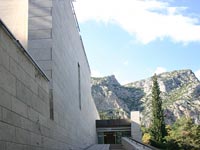| Fokida Prefecture |
 The Museum of Delphi has 12 rooms in which many of the sculptures and the treasures found are located. As we enter the museum we face the «navel of the world», a marble replica of the Sacred Stone that was in the temple of Apollo.
The Museum of Delphi has 12 rooms in which many of the sculptures and the treasures found are located. As we enter the museum we face the «navel of the world», a marble replica of the Sacred Stone that was in the temple of Apollo.
We pass by three bronze shields, with carvings of animals that date back to the 7th century BC and we move into a room where two statues of young men, stand tall. This type of statue, of a naked, standing young man, was called «Kouros» and in this case they represent two brothers, Kleoves and Vitonas, from the city of Argos. In the same area we also find five glyphs from the treasure of the Sikionians with various presentations. In an adjacent room we find pieces of Sifnian treasures, probably the best and most important of the treasures. They present the council of the gods in Olympus, the battle between Greeks and Trojans, the battle of the Giants and the gods, "Paris's choice" and Hippodamias's depredation. In the same room we can also admire the imposing sphinx which stood in the temple of Apollo near the treasures of the Athenians. As we move into the museum we see more from the treasures of Delphi, such as the 24 metopes, with various presentations, of treasures of the Athenians. The two next rooms include the remains of the temple of Apollo, with the pediments, two statues with carved hymns dedicated to Apollo and the gargoyle with the lion's head. In the room with the tombs we find an amazing glyph representing a young athlete, part of a Dionysus statue and a round marble altar. The room further inside the museum includes pieces of Tholos, the temple of Athena Pronaia. We can see parts of the frieze and many more small sculptures and statues from the same building. Our next stop, Aghia's room, includes 10 statues, six men of Aghia's family (including him), an old man, probably a philosopher and 3 women standing gracefully on a column. The last two rooms of the museum, house two great statues, one of a charioteer and one of Adinoos. In the first room the bronze statue presents a charioteer after the ending of the games. The design included four horses with a chariot, the charioteer and a young horse-groom. As we visit the final room, we find an exquisite statue of a handsome man, called Adinoos, who died at a young age and was worshipped as a half-god/half-human by the entire Greek-Roman world. |
|
| Hotels - Apartments - Suites throughout Greece | Car Rentals throughout Greece | Travel Agencies throughout Greece |
| Cruises & Sailing Yacht Charters in Greece |